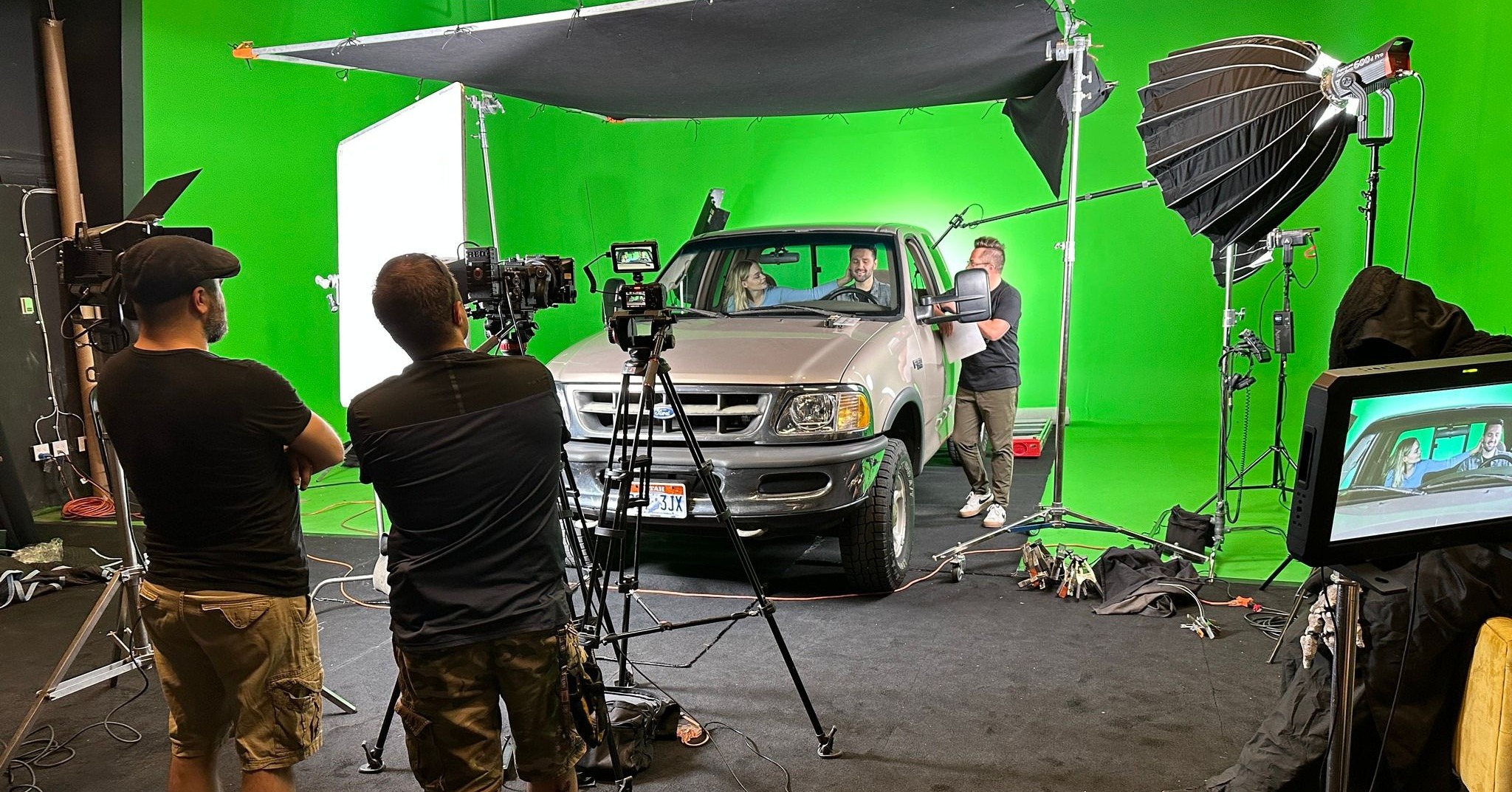Best Post-Production Services with Video Examples
Post-production is a crucial phase in the filmmaking process that begins after principal photography or recording has ended. This stage encompasses a variety of tasks, all aimed at refining and finalizing the project. These can include editing the raw footage, color grading for aesthetic and mood consistency, adding special effects and computer-generated imagery, sound design and mixing, and post-synchronization or dubbing. The goal is to improve and perfect the audiovisual content, ensuring it tells the desired story in the most effective way possible. Often, it’s in post-production that the film or video truly comes to life, as disparate elements are woven together into a cohesive, polished final product.

Image of video shoot where a green screen will be changed in post production.
There are four steps in the post-production process.
Editing the Shot Footage
Editing is a fundamental step in post-production and is often referred to as the “invisible art” due to its ability to shape a story without the audience noticing. It involves arranging, trimming, and combining shots to craft a cohesive and engaging narrative from raw footage. The importance of editing extends beyond simply piecing together the story—it also involves controlling pacing, creating mood, and guiding viewer attention. For instance, fast-paced editing can create excitement or tension, while slower cuts might establish a calm or contemplative tone. Editing also allows for the creation of dramatic effects through techniques such as cross-cutting or flashbacks. Furthermore, it can enhance performances by choosing the best takes or even manipulating reactions. In essence, editing in post-production is crucial as it shapes the raw footage into a meaningful story that connects with the audience and conveys the intended message effectively.
Laying in the Special Effects Footage
Whether it is motion graphics or something more complex special effects can really make a video stand out. Special effects play a crucial role in commercial video production, significantly elevating its impact and the viewer’s engagement. Whether it’s CGI (computer-generated imagery), compositing, or practical effects, these techniques can enhance storytelling by creating visuals that are impossible or impractical to film in reality. For instance, a commercial might require a product to fly, explode, or transform, scenarios where special effects would be indispensable. By seamlessly integrating special effects, producers can create captivating, high-quality content that not only catches the eye but also effectively communicates the commercial’s message. In essence, laying in special effects has the power to bring a creative vision to life, enabling the commercial to stand out in today’s saturated media landscape.
Laying in the Score and Editing the Sound
Sound editing and balancing are an integral part of post-production that significantly impacts the viewer’s experience and interpretation of a commercial. It involves various tasks such as dialogue editing, sound effects, foley, and mixing. Sound editing not only ensures clear dialogue but also enhances the story or message by adding depth and texture through sound effects and background audio. The right sound can accentuate the emotion of a scene, whether it’s the upbeat rhythm of a summer sale advertisement or the hushed tones of a luxury product showcase.
Balancing, or mixing, is the process of adjusting levels between different sound sources to achieve a harmonious blend. A well-balanced mix ensures the most important elements, such as key dialogue or specific sound effects, are clearly audible without being drowned out by background noise or music. It also creates a spatial representation, providing the viewer with a sense of depth and directionality in the soundscape.
Grading or Correcting the Color of the Footage
Grading or color-correcting footage is one of the most important steps of post-production. In this step, you can take average footage and really make it pop. Color grading or correcting in commercial video footage is paramount for both aesthetic and storytelling purposes. This process can significantly influence the viewer’s perception and emotional response. Through color grading, a commercial can create a specific mood, highlight key aspects, and maintain consistency, which is especially important for brand identity. For instance, warmer tones might evoke feelings of comfort and familiarity, while cooler tones could suggest a more high-tech, modern vibe. Grading can also be used to draw attention to a specific product or part of the scene, thereby guiding the viewer’s focus. Moreover, color correction ensures that the footage looks as intended across different viewing platforms, taking into account various screen calibrations and lighting conditions. Overall, the importance of color grading and correction lies in its power to enhance the overall visual communication and narrative of a commercial, making it more engaging and effective.
Zero Fatalities – Signs And Signals Commercial – 4K from Savvy Productions on Vimeo.
Frequently asked questions about post-production
What are the 4 steps of post-production?
The four steps of post-production typically include editing the footage, sound design and editing, color grading or correcting, and adding special effects or computer-generated imagery.
What are the examples of post-production?
Examples of post-production work include cutting and arranging scenes to create a cohesive narrative (editing), enhancing or manipulating the audio quality and components (sound design), adjusting the visual tone and mood (color grading), and creating realistic, non-practical elements (special effects).
What does post-production work include?
Post-production work includes tasks like editing raw footage, sound editing and mixing, color correction and grading, visual effects integration, music scoring, and sometimes dubbing or subtitles for different languages.
How much does post-production cost?
The cost of post-production can vary significantly based on the complexity of the project, the desired quality, and the location.